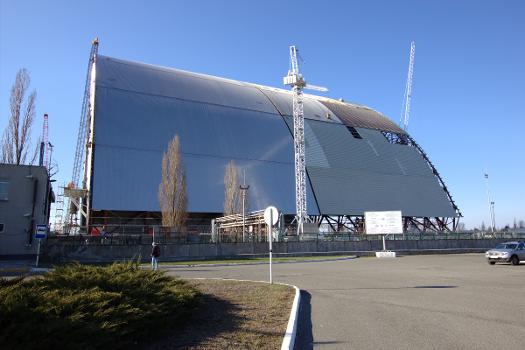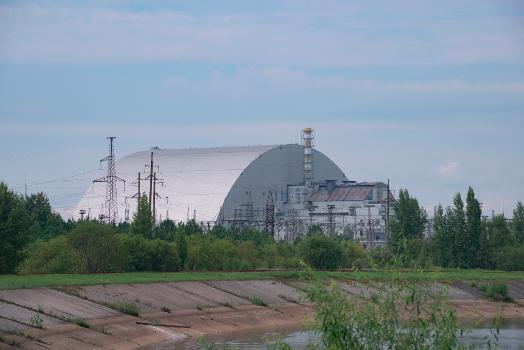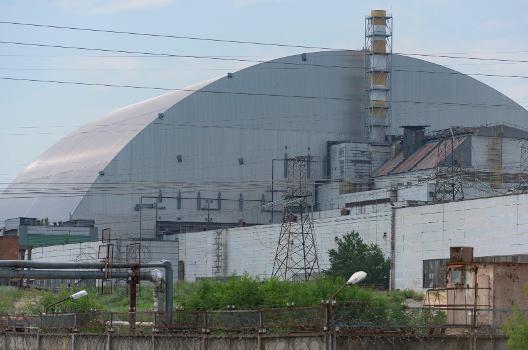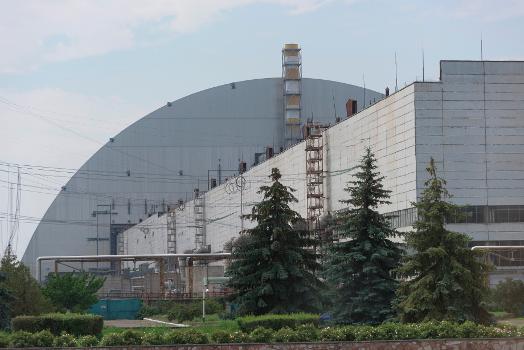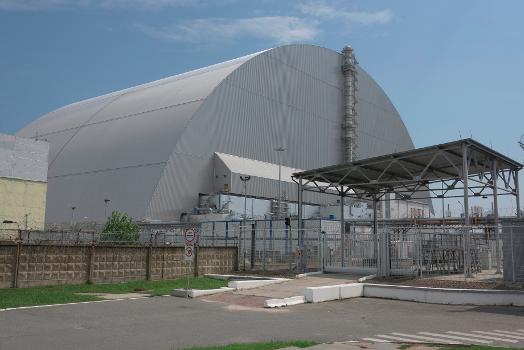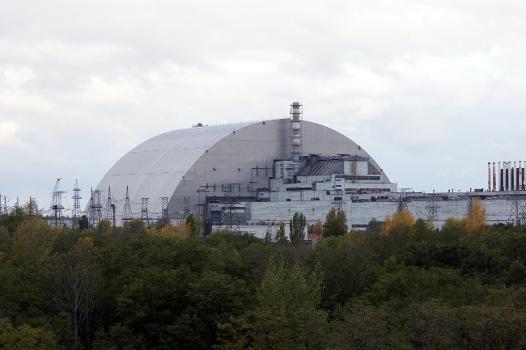General Information
Project Type
| Material: |
Steel structure |
|---|---|
| Structure: |
Two-hinged arch Truss arch |
| Equipment: |
Structurae Plus/Pro - Subscribe Now! |
Location
| Location: |
Pripyat, Kyiv Oblast, Ukraine |
|---|---|
| Coordinates: | 51° 23' 21.05" N 30° 5' 55.76" E |
Technical Information
Dimensions
| height | 108 m | |
| length | 162 m | |
| arches | span | 257 m |
| number | 16 |
Materials
| truss |
steel
|
|---|
Excerpt from Wikipedia
The New Safe Confinement (NSC or New Shelter, rarely Arka) is a structure put in place in 2016 to confine the remains of the number 4 reactor unit at the Chernobyl Nuclear Power Plant, in Ukraine, which was destroyed during the Chernobyl disaster in 1986. The structure also encloses the temporary Shelter Structure (sarcophagus) that was built around the reactor immediately after the disaster. The New Safe Confinement is designed to prevent the release of radioactive contaminants, protect the reactor from external influence, facilitate the disassembly and decommissioning of the reactor, and prevent water intrusion.
The New Safe Confinement is a megaproject that is part of the Shelter Implementation Plan and supported by the Chernobyl Shelter Fund. It was designed with the primary goal of confining the radioactive remains of reactor 4 for the next 100 years. It also aims to allow for a partial demolition of the original sarcophagus, which was hastily constructed by Chernobyl liquidators after a beyond design-basis accident destroyed the reactor.
The word confinement is used rather than the traditional containment to emphasize the difference between the containment of radioactive gases—the primary focus of most reactor containment buildings—and the confinement of solid radioactive waste, which is the primary purpose of the New Safe Confinement.
In 2015, the European Bank for Reconstruction and Development (EBRD) stated that the international community was aiming to close a €100 million funding gap, with administration by the EBRD in its role as manager of the Chernobyl decommissioning funds. The total cost of the Shelter Implementation Plan, of which the New Safe Confinement is the most prominent element, is estimated to be around €2.15 billion (US$2.3 billion). The New Safe Confinement accounts for €1.5 billion.
The French consortium Novarka with partners Vinci Construction Grands Projets and Bouygues Travaux Publics designed and built the New Safe Confinement. Construction was completed at the end of 2018.
Legacy structure
The original shelter, formally referred to as the Shelter Structure and often called the sarcophagus, was constructed between May and November 1986. It was an emergency measure to confine the radioactive materials within reactor 4 at the Chernobyl nuclear power plant. The shelter was constructed under extreme conditions, with very high levels of radiation, and under extreme time constraints. The Shelter Structure was moderately successful in confining radioactive contamination and providing for post-accident monitoring of the destroyed nuclear reactor unit; it has been estimated that up to 95% of the original radioactive inventory of reactor 4 remains inside the ruins of the reactor building.
The Shelter Structure is primarily supported by the damaged remains of the reactor 4 building. These are largely considered to be structurally unsound as a result of explosive forces caused by the accident. Three major structural members support the roof of the Shelter Structure. Two beams, usually referred to as B-1 and B-2, run in an east-west direction and support the roof beams and panels. A third, more massive member, the "Mammoth Beam", spans the largest distance across the roof from east to west and assists in supporting the roof beams and panels. The roof of the shelter consists of 1 metre (3 ft 3 in) diameter steel pipes laid horizontally north to south, and steel panels that rest at an angle, also in the north-south direction.
The Shelter Structure was never intended to be a permanent containment structure. Its continued deterioration has increased the risk of its radioactive inventory leaking into the environment. Between 2004 and 2008, workers stabilized the roof and western wall of the shelter. However, construction of the New Safe Confinement was necessary to continue confining the radioactive remains of Chernobyl Nuclear Power Plant reactor 4.
Further upgrades to the area in preparation for New Safe Confinement construction were completed in 2010. These included road and rail connections, site services (power, water, drains, and communications), facilities for workers (including medical and radiation protection facilities), and the installation of a long-term monitoring system.
International design competition
In 1992, Ukraine's government held an international competition for proposals to replace the sarcophagus.
In the autumn of 1992, Design Group Partnership (DGP) of Manchester was invited to assist the Atomic Energy Authority (AEA) for the UK's submission for the international competition organized by the Ukrainian government.
DGP's senior management was assembled to generate a solution. David Haslewood suggested an arch, built off-site, and then slid over the existing Soviet-built sarcophagus because:
- Off-site construction would minimize radiation doses of construction workers.
- An arch would fit snugly over the damaged reactor excluding its chimney.
- An arch would be easier to slide than a square box.
Of the 394 entries, only the British submission proposed a sliding arch approach. There was no top design choice, but the French submission came as second best with the UK and German proposals coming joint third.
Subsequently, a pan-European study (the TACIS programme) re-examined the proposals of the competition's top three finalists. The study selected the sliding arch concept as the best solution for their further investigations and recommendations, primarily to reduce the chance of the construction workers receiving a harmful dose of radiation. The French consortium named Novarka eventually won the contract for the final sliding arch design.
On 17 September 2007 Vinci Construction Grands Projets and Bouygues Travaux Publics announced that they won the contract to design and build the New Safe Confinement as 50/50 partners of the French consortium Novarka. The original 432 million euros contract comprises the design and construction of the New Safe Confinement and planned to employ 900 people at its peak.
The project has involved workers and specialists from at least 24 countries in addition to Ukraine.
Structural design
The New Safe Confinement design is an arch-shaped steel structure with an internal height of 92.5 metres (303.5 ft) and a 12-metre (39.4 ft) distance between the centers of the upper and lower arch chords. The internal span of the arch is 245 metres (803.8 ft), and the external span is 270 metres (885.83 ft). The dimensions of the arch were determined based on the need to operate equipment inside the new shelter and decommission the existing shelter. The overall length of the structure is 150 metres (492.1 ft), consisting of 13 arches assembled 12.5 metres (41 ft) apart to form 12 bays. Vertical walls assembled around, but not supported by the existing structures of the reactor building seal the ends of the structure.
The arches are constructed of tubular steel members and are externally clad with three-layer sandwich panels. These external panels are also used on the end walls of the structure. Internally, polycarbonate panels cover each arch to prevent the accumulation of radioactive particles on the frame members.
Large parts of the arches were shop-fabricated and transported to the assembly site 180 metres (590 ft) west of reactor 4. Each of the steel tubes is made of high-strength steel to reduce cost and assembly weight. The steel used in the construction of the tubular members has a yield strength of no less than 2,500 kg/cm² (250 MPa; 36,000 psi).
Warm, dry air will be circulated in the gap between inner and outer roof sections to prevent condensation, which will reduce corrosion and prevent water from dripping into the interior.
Design goals
The New Safe Confinement was designed with the following criteria:
- Convert the destroyed Chernobyl Nuclear Power Plant reactor 4 into an environmentally safe system (i.e., confine the radioactive materials at the site to prevent further environmental contamination).
- Reduce corrosion and weathering of the existing shelter and the reactor 4 building.
- Mitigate the consequences of a potential collapse of either the existing shelter or the reactor 4 building, particularly in terms of confining the radioactive dust that would be produced by such a collapse.
- Enable safe demolition of unstable structures (such as the roof of the existing shelter) by providing remotely operated equipment for their demolition.
- Qualify as a nuclear entombment device.
Foundation design
The foundations of the New Safe Confinement were designed to meet the primary requirements:
- They must support the weight of the arches of the New Safe Confinement.
- They must support rail tracks across which the New Safe Confinement can roll 180 metres (590 ft) from the construction site into place over reactor 4.
- They must minimize the amount of digging and cutting into the upper layers of the ground, as the upper soil is heavily contaminated with nuclear material from the disaster.
The site of the New Safe Confinement is slightly sloped, ranging in elevation from 117.5 metres (385 ft) on the eastern side to 144 metres (472 ft) on the western side. The foundation was required to account for this difference without extensive site leveling.
The ground upon which the foundation was built is unique in that it contains a technogenic layer just below the surface that is approximately 2.5 to 3 metres (8 to 10 ft) in overall depth. Radioactive contamination from the accident created the technogenic layer. It consists of various materials including nuclear material, stone, sand, loamy sands, unreinforced concrete, and construction wastes. It is considered unfeasible to determine the geotechnical characteristics of this soil layer. As a result of this, no assumptions about the load-bearing properties of the technogenic layer were made during the design of the foundation.
The water table at Chernobyl Nuclear Power Plant fluctuates from 109.9 metres (360.6 ft) on average in December to 110.7 metres (363.2 ft) on average in May.
Several options were considered for the foundation design for the New Safe Confinement. Ultimately, the final design was specified as consisting of three lines of two 4.50-by-1.00-metre (14.76 by 3.28 ft) foundation panels, each 21 metres (68.9 ft) in length, and a 4-metre (13.1 ft) high pile cap that reaches to a height of 118 metres (387 ft) of elevation. This option was selected to minimize the cost of the foundation, the number of cuts into radioactive soil layers, dose uptake of workers, and risk to the environment from further contamination. The foundation has a slight elevation difference between the area in which the New Safe Confinement was constructed and the final resting area around reactor 4.
Special consideration was necessary for the excavation required for foundation construction due to the high level of radioactivity found in the upper layers of soil. The conceptual designers of the New Safe Confinement recommended the use of rope operated grabs for the first 0.3 metres (11.8 in) of pile excavation for the Chernobyl site. This reduced the direct exposure of workers to the most contaminated sections of the soil. Deeper excavation for the foundation piles were accomplished using hydraulic clam shells operated under bentonite slurry protection.
The foundation is designed to withstand horizontal acceleration structural loads of up to 0.08 g, as well as to withstand an F3 tornado. The original design for the structure required it to withstand an F1 tornado until an independent beyond-design-basis analysis was carried out to evaluate the effects of an F3 tornado on the structure.
Assembly process
The system used in the assembly of the New Safe Confinement derived from civilian bridge launching and bridge cantilever methods. The New Safe Confinement was assembled in the following steps:
- Stabilization of the Shelter Structure to prevent collapse during construction.
- Excavation and construction of the foundation.
- Assembly of first and second arches to form Bay 1, installation of east wall on arch 1.
- Bay 1 was slid East to accommodate the construction of arch 3 and Bay 2.
- Subsequent sliding of the complete structure and adding of arches and bays to complete the structure.
- Installation of cranes and large maintenance equipment.
- Installation of the west wall.
- Final slide into place over reactor 4.
- Deconstruction of the fragmentation, decontamination, and auxiliary buildings. (planned)
This process of assembly was deemed advantageous because it took advantage of the designed mobility of the structure to maximize the distance between workers and the reactor building, thereby minimizing their exposure to radiation.
As each bay was completed, infrastructure equipment—including that for ventilation systems, radiation monitoring, plumbing, and electrical was installed.
Positioning
The New Safe Confinement was constructed 180 metres (590 ft) west of reactor 4, and slid into place. Sliding of the structure along foundation rails was a difficult process. It was pushed on Teflon pads by hydraulic pistons, and guided by lasers. As of 2018, the New Safe Confinement is the world's largest movable land-based structure.
Two options were initially considered for moving the structure: hydraulic jacks to push the structure forward, or pulling the structure with large, multi-stranded steel cables. The first option would require the relocation of the hydraulic jacks after each push. This process would necessitate more worker interaction with the system and a greater worker exposure to radiation. The second option was initially chosen because it would expose workers to a lower radiation dose, and would have moved the structure into its final position in less than 24 hours. However, the structure was moved using hydraulic jacks, beginning the 327-metre (1,073 ft) move on November 14, 2016, and finishing on November 29.
Demolition of existing structures
The operational phase of the New Safe Confinement involves the demolition of the unstable structures associated with the original Shelter Structure. The goal of demolition has imposed significant requirements upon the load carrying capacity of the arches and foundation of the New Safe Confinement, as these structures must carry the weight of not only the disassembled structure, but also the suspended cranes to be used in demolition.
Demolition equipment
The New Safe Confinement design includes two bridge cranes suspended from the arches. These cranes travel east to west on common runways and each has a span of 84 metres (276 ft).
Each crane can carry a variety of interchangeable carriages. Three types of carriages have been designed for the New Safe Confinement:
- One typical lifting carriage with a 50-tonne (55-ton) carrying capacity.
- One secure lifting carriage for shielded transportation of personnel, with a 50-tonne (55-ton) carrying capacity.
- One carriage suspends a mobile tool platform, extending up to 75 metres (246 ft), that can be fitted with a variety of end actuators useful for demolition.
The cranes' carriage interchangeability allows the rotation of the largest members to be demolished, reducing the overall size of the New Safe Confinement by approximately one arch bay.
After the members to be demolished are removed by crane they must be fragmented into pieces small enough to decontaminate. It is expected that the primary contamination of most demolished elements will be loose surface dust and can easily be removed. Decontamination will take place using vacuum cleaners with HEPA filters, grit blasting (for steel elements), and scarifying (for concrete elements). Once decontaminated to the maximum extent practical, pieces will be further fragmented for eventual disposal. Fragmentation tools include plasma arc cutting torches, diamond circular cutting wheels, and diamond wire cutting. The tools selected for the demolition process were selected based on a number of factors including minimization of individual and collective radiation exposure, the amount of secondary waste generated, the feasibility of remote operation, the cutting efficiency, fire safety, capital cost and operating costs.
The exact methods for disposing of wastes generated by the demolition process have not been determined, and may include on-site burial outside the New Safe Confinement for low-level waste, and long-term storage inside the New Safe Confinement for medium and high-level wastes. As of 2018, no policy has been decided for the disposal and processing of fuel containing materials.
Types of materials to be demolished
The elements that are to be demolished fall into several broad material types:
- Steel
- Flat (roof panels)
- Three-dimensional (pipes, trusses, beams)
- Reinforced concrete
- Pre-cast
- Cast in place
- Debris
- Fragments of steel structures and equipment
- Fragments of reinforced concrete structures
- Materials added after the Chernobyl accident to mitigate its consequences.
Waste storage
Near to the Chernobyl site, the Vector Radioactive Waste Storage Facility is being built, consisting of the Industrial Complex for Solid Radwaste Management (ICSRM), a nuclear waste storage site. It is being constructed by Nukem Technologies, a German nuclear decommissioning company, a subsidiary of the Russian Atomstroyexport. This storage is reported to be able to contain 75,000 cubic metres (98,000 cubic yards) of material. The storage is for both temporary high level waste as well as low and intermediate level long-term waste storage.
Worker safety and radioactive exposure
Radioactive dust in the shelter is monitored by hundreds of sensors. Workers in the 'local zone' carry two dosimeters, one showing real-time exposure and the second recording information for the worker's dose log.
Workers have a daily and annual radiation exposure limit. Their dosimeter beeps if the limit is reached and the worker's site access is cancelled. The annual limit (20 millisieverts) may be reached by spending 12 minutes above the roof of the 1986 sarcophagus, or a few hours around its chimney.
Responsible organizations
The European Bank for Reconstruction and Development (EBRD) is responsible for managing the Shelter Implementation Plan, including overseeing the construction of the New Safe Confinement.
Russian invasion of Ukraine
In February 2022, Russian forces invaded many parts of Ukraine, including Chernobyl. Following the occupation of the Chernobyl Exclusion Zone, the International Atomic Energy Agency reported an uptick in radiation output, though still below harmful levels.
Text imported from Wikipedia article "Chernobyl New Safe Confinement" and modified on March 11, 2022 according to the CC-BY-SA 4.0 International license.
Participants
Relevant Web Sites
Relevant Publications
- (2018): Chernobyl New Safe Confinement project – Steel arch permanent bearing. Presented at: IABSE Symposium: Tomorrow’s Megastructures, Nantes, France, 19-21 September 2018, pp. S1-33.
- (2018): The Chernobyl Shelter: a Mega-structure for a Safe Confinement. Presented at: IABSE Symposium: Tomorrow’s Megastructures, Nantes, France, 19-21 September 2018, pp. K-37.
- (1997): A second shelter for Chernobyl: its necessity and feasibility. In: Proceedings of the Institution of Civil Engineers - Civil Engineering, v. 120, n. 1 (February 1997), pp. 2-14.
- About this
data sheet - Structure-ID
20082453 - Published on:
07/03/2022 - Last updated on:
07/03/2022

